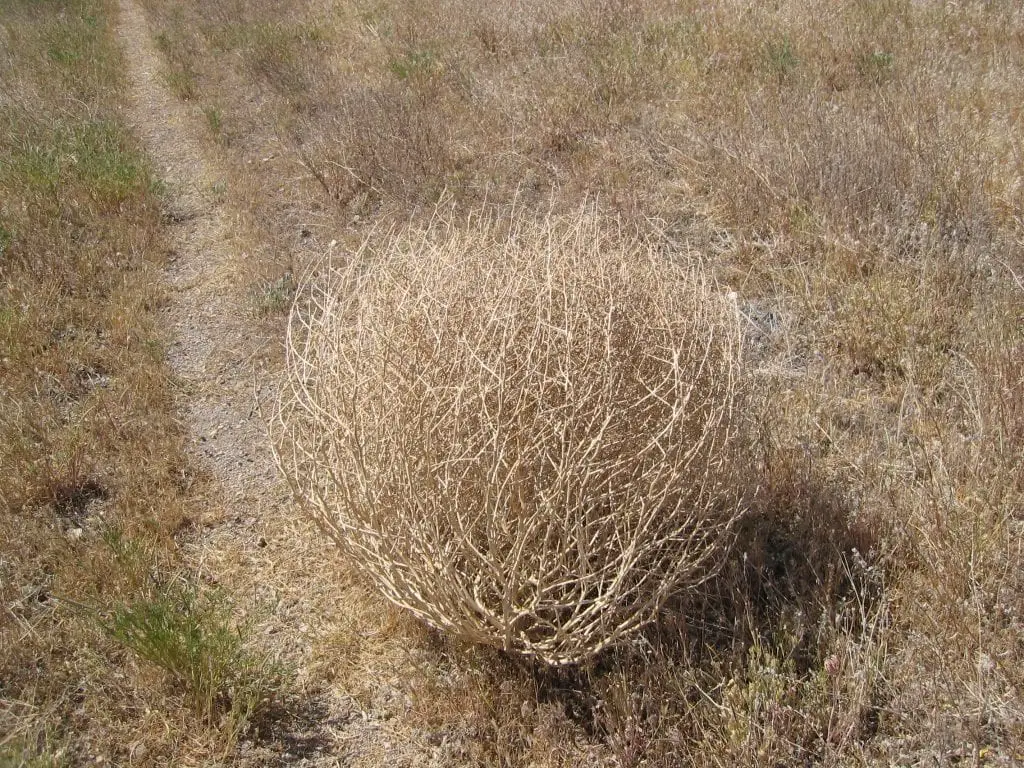

Image – Wikimedia / ImperfectTommy / Edmond Meinfelder
Have you ever seen photos of a desert ball? I admit that the first time I saw one, I did not imagine what it was exactly. It is shaped like a ball, yes, but what is it? Well, neither more nor less than some type of plant that has dried up.
It is quite common in semi-arid areas, and although it may seem incredible, we also have it in Spain. I will explain to you below what are their characteristics.
What are the characteristics of the desert ball?
This strange plant is known as estepicursor in botany. They are a group of species that, once they produce fruits and seeds, dry up. In doing so, the wind carries them, something that comes in handy since their fruits and / or seeds are released, often very far from the mother plant. In this way, as soon as the rains arrive, a new cycle will begin which consists of germinating – growing – flowering – fruiting – dying … and waiting to be blown away by the wind.
Virtually the entire plant is made up of diasporas, that is, units that allow plants to engender a new generation. These structures can be produced asexually or, what is more common in steppers, sexually, that is, through the pollination of their flowers.
What plants turn into balls of the desert?
There are many, but we are going to stick with the ones that are easier to get, in case you want to have your own in the garden or in a pot :
Hierochuntic Anastatica


Image – Flickr/Boubder
Known as the Rose of Jericho, it is native to the deserts of Arabia, Palestine and Egypt. It is a very curious plant, with short roots and divided leaves. During the dry period, it is common for the wind to tear it off the ground and drag it with it, benefiting it greatly since it can thus release the seeds in other parts.
However, when it rains its leaves rehydrate, and as they do so they open, turn green again from chlorophyll, and shortly afterwards it blooms.

Related article:
Rose of Jericho, the plant that resurrects
eryngium campestre


Image – Wikimedia Commons / Wikimedia Commons
Known as runner thistle, mail thistle, setero thistle or tinder thistle, it is a perennial herbaceous plant native to central and western Europe, North Africa, the Middle East and the Caucasus. It reaches a height of 70 centimeters, from which spiny and lobed leaves sprout.
The flowers are grouped in heads, bluish in colorand produce nuts with seeds. At the end of fruiting, the aerial part, that is, the visible part, dries up, leaving only the root that is tuberous and the one that will be responsible for giving life to new leaves in spring.
Uses
It is usually considered as a weed, but you have to know that it is very interesting because has healing and diuretic properties. In addition, its young leaves and roots are a good ingredient for salads.

Related article:
Runner thistle (Eryngium campestre)
Kali Salsola


Image – Wikimedia Commons / Albert Salguero
Known as almajo de jaboneros, salicor de la Mancha, capitana or barrilla edge, it is an annual plant native to the rather dry regions of Eurasia. Grows up to a maximum height of one meter, with stems that branch heavily from the base. The branches grow curved towards the stems, and from them sprout cylindrical leaves with the spiny apex.
Blooms in summer (July to September in the northern hemisphere). Its flowers are solitary, 5 to 9mm, and whitish in color. The fruit is small, although it can contain up to a million seeds of about 2mm in diameter.
Uses
By having a very high sodium concentration (around 6% solid matter), its ashes were used to make glass and to make soda.
Selaginella lepidophylla


Image – Wikimedia Commons / Wikimedia Commons
Known as the resurrection plant, stone flower or doradilla, It is a plant with roseate stems, tussocks, with brown leaves. It does not produce flowers or seeds, since it is a family species of ferns. It does have sporophytes instead, but they are hardly visible.
She is a born survivor: is able to survive in a dormant state for several years until it is hydrated again, hence it is thought that it ‘resurrects’, although in reality it was never dead .
How are they cared for?
If you want to have a copy, we recommend that you provide it with the following care:
Location
They are plants that must be abroadfull sun.
Earth
- Flower pot: mix universal substrate (on sale here!) with equal parts perlite.
- Garden: requires a light, sandy soil with excellent drainage.
Irrigation
Rather little. Water when the soil is almost dry. During the summer give 2-3 weekly irrigations.
Subscriber
In spring and summer It is advisable to fertilize them with a little organic compost, such as guano, compost or manure.
Multiplication

The majority multiply by seeds in springfollowing this step by step:
- First, fill a pot or, better, a seedling tray with universal substrate mixed with perlite in equal parts.
- Then water conscientiously.
- Then, place a maximum of two to three seeds in each seedbed, or if necessary, in each socket.
- Then cover them with a thin layer of substrate.
- Finally, water again and place the seedbed outside, in full sun.
That way they will germinate in about two weeks.
Planting or transplanting time
In springwhen the frosts have passed.
Rusticity
Except for Eryngium, which can withstand weak frosts, the rest suffers damage when the temperature drops below 0 degrees.
What did you think of the desert balls?
